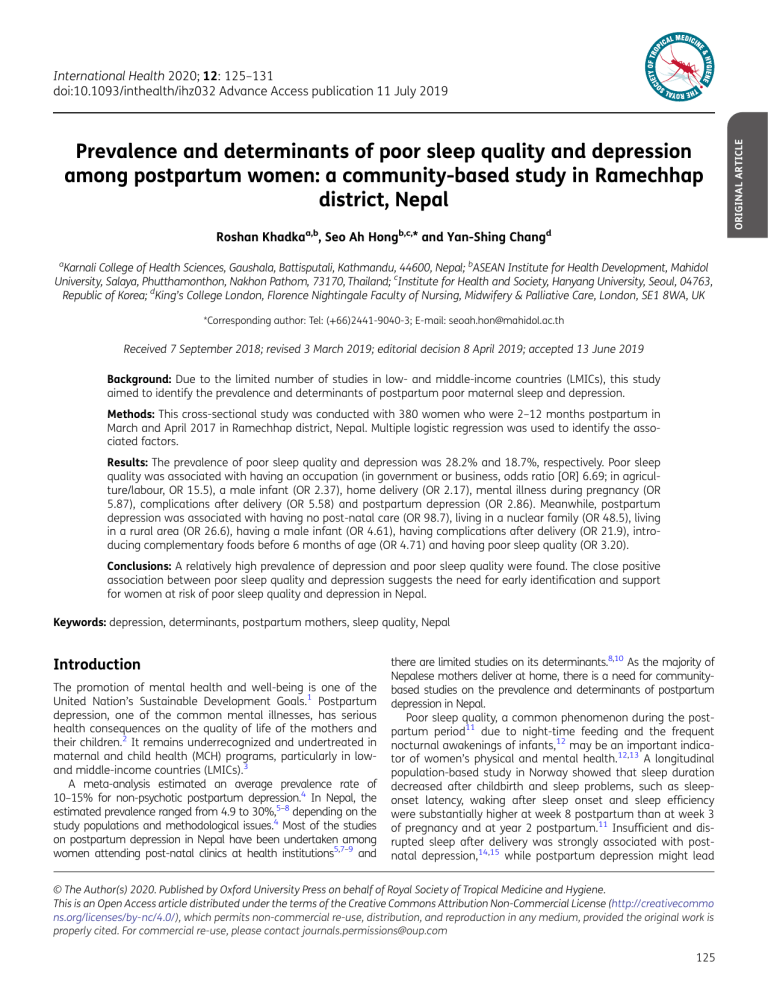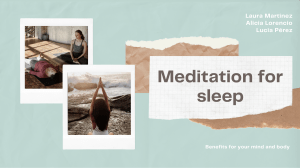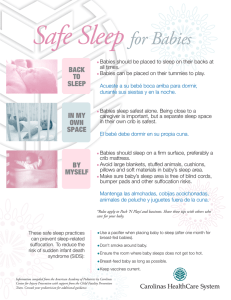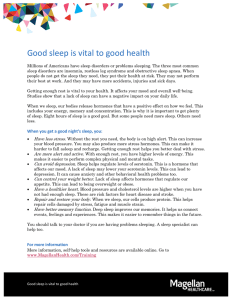
Prevalence and determinants of poor sleep quality and depression among postpartum women: a community-based study in Ramechhap district, Nepal Roshan Khadkaa,b, Seo Ah Hongb,c,* and Yan-Shing Changd a Karnali College of Health Sciences, Gaushala, Battisputali, Kathmandu, 44600, Nepal; bASEAN Institute for Health Development, Mahidol University, Salaya, Phutthamonthon, Nakhon Pathom, 73170, Thailand; cInstitute for Health and Society, Hanyang University, Seoul, 04763, Republic of Korea; dKing’s College London, Florence Nightingale Faculty of Nursing, Midwifery & Palliative Care, London, SE1 8WA, UK *Corresponding author: Tel: (+66)2441-9040-3; E-mail: [email protected] Received 7 September 2018; revised 3 March 2019; editorial decision 8 April 2019; accepted 13 June 2019 Background: Due to the limited number of studies in low- and middle-income countries (LMICs), this study aimed to identify the prevalence and determinants of postpartum poor maternal sleep and depression. Methods: This cross-sectional study was conducted with 380 women who were 2–12 months postpartum in March and April 2017 in Ramechhap district, Nepal. Multiple logistic regression was used to identify the associated factors. Results: The prevalence of poor sleep quality and depression was 28.2% and 18.7%, respectively. Poor sleep quality was associated with having an occupation (in government or business, odds ratio [OR] 6.69; in agriculture/labour, OR 15.5), a male infant (OR 2.37), home delivery (OR 2.17), mental illness during pregnancy (OR 5.87), complications after delivery (OR 5.58) and postpartum depression (OR 2.86). Meanwhile, postpartum depression was associated with having no post-natal care (OR 98.7), living in a nuclear family (OR 48.5), living in a rural area (OR 26.6), having a male infant (OR 4.61), having complications after delivery (OR 21.9), introducing complementary foods before 6 months of age (OR 4.71) and having poor sleep quality (OR 3.20). Conclusions: A relatively high prevalence of depression and poor sleep quality were found. The close positive association between poor sleep quality and depression suggests the need for early identification and support for women at risk of poor sleep quality and depression in Nepal. Keywords: depression, determinants, postpartum mothers, sleep quality, Nepal Introduction The promotion of mental health and well-being is one of the United Nation’s Sustainable Development Goals.1 Postpartum depression, one of the common mental illnesses, has serious health consequences on the quality of life of the mothers and their children.2 It remains underrecognized and undertreated in maternal and child health (MCH) programs, particularly in lowand middle-income countries (LMICs).3 A meta-analysis estimated an average prevalence rate of 10–15% for non-psychotic postpartum depression.4 In Nepal, the estimated prevalence ranged from 4.9 to 30%,5–8 depending on the study populations and methodological issues.4 Most of the studies on postpartum depression in Nepal have been undertaken among women attending post-natal clinics at health institutions5,7–9 and there are limited studies on its determinants.8,10 As the majority of Nepalese mothers deliver at home, there is a need for communitybased studies on the prevalence and determinants of postpartum depression in Nepal. Poor sleep quality, a common phenomenon during the postpartum period11 due to night-time feeding and the frequent nocturnal awakenings of infants,12 may be an important indicator of women’s physical and mental health.12,13 A longitudinal population-based study in Norway showed that sleep duration decreased after childbirth and sleep problems, such as sleeponset latency, waking after sleep onset and sleep efficiency were substantially higher at week 8 postpartum than at week 3 of pregnancy and at year 2 postpartum.11 Insufficient and disrupted sleep after delivery was strongly associated with postnatal depression,14,15 while postpartum depression might lead © The Author(s) 2020. Published by Oxford University Press on behalf of Royal Society of Tropical Medicine and Hygiene. This is an Open Access article distributed under the terms of the Creative Commons Attribution Non-Commercial License (http://creativecommo ns.org/licenses/by-nc/4.0/), which permits non-commercial re-use, distribution, and reproduction in any medium, provided the original work is properly cited. For commercial re-use, please contact [email protected] 125 ORIGINAL ARTICLE International Health 2020; 12: 125–131 doi:10.1093/inthealth/ihz032 Advance Access publication 11 July 2019 R. Khadka et al. to disturbed sleep.16 In addition, poor sleep quality was found to be associated with stressful life events, a poor partner relationship12,15 and inadequate physical and emotional care for the child.13 However, poor sleep quality is frequently dismissed by health professionals and there is a lack of studies in LMICs such as Nepal. Nepal has made substantial progress in reducing maternal mortality, due to improvements in women’s utilization of maternal health care services. However, access to maternal health care and provisions for maternal mental illness remain poor. Continuous efforts are needed to improve the mental health as well as the physical health of mothers through screening or preventive interventions for depression and poor sleep quality within MCH services. This cross-sectional study aimed to assess health care needs by evaluating the prevalence and determinants of poor sleep quality and depression and their association among postpartum mothers in Ramechhap district, Nepal. This study also aimed to provide evidence for public health policy to manage postpartum depression and poor sleep quality among women in Nepal. Methods Study design and participants subjective sleep quality, sleep latency, sleep duration, habitual sleep efficiency, sleep disturbances, use of sleeping medication and daytime dysfunction. Component scores range from 0 to 3 and are summed to obtain a global score, which ranges from 0 to 21. Higher scores indicate more sleep disturbance experienced and a global score >5 indicates a significant sleep disturbance. Cronbach’s α was 0.80 (0.83 in the original sample18). Postpartum depression was assessed with the Patient Health Questionnaire-2 (PHQ-2), which performed well for identifying depression in primary care centres with large samples.19 The two questions used to identify postpartum depression in the PHQ-2 are ‘Over the past 2 weeks, how often have you been bothered by any of the following problems? 1) Little interest or pleasure in doing things; 2) Feeling down, depressed or hopeless.’ The response options were i) not at all, ii) several days, iii) more than half the days and iv) nearly every day. Each question item has a score ranging from 0 to 3. The total score ranges from 0 to 6. The mothers with a score ≥3 as the optimal cut-off point for screening purposes were considered as depressed. All covariates were obtained by face-to-face interviews. Sociodemographic variables including maternal education and occupation, monthly family income, type of family, residence, age at last delivery, number of children <5 y of age, age of infant and sex of infant were collected by means of a questionnaire. Ante- and perinatal factors included having mental problems like depression during pregnancy, antenatal care visits at least once, place of delivery, delivery mode and experiencing complications of the mother or the child during pregnancy or delivery. Mental problems during pregnancy were assessed with a question, ‘Did you have any mental distress like depression during pregnancy?’ (‘yes’ or ‘no’). Experiencing complications of the mother or the child during pregnancy or delivery was assessed with a question, ‘Did you experience any complications during pregnancy or delivery?’ (‘yes’ or ‘no’). Post-natal factors included experiencing complications of the mother or the child after delivery, PNC visits at least once, child still being breastfed and timing of introducing complementary food. Experiencing complications of the mother or the child after delivery was also measured with one question, ‘Did you experience any complications after delivery?’ (‘yes’ or ‘no’). This cross-sectional community-based study was conducted in Ramechhap district, Nepal in March and April 2017. Manthali municipality was purposively selected from Ramechhap district due to a lower prevalence of post-natal care (PNC) utilization compared with that of other municipalities. Four of seven village development committees (VDCs) and mothers from each VDC were randomly selected. Mothers who had an infant and who were at least 6 weeks post-natal (2–12 months of child’s age) were invited, while mothers who were mute, had a hearing impairment, were unwilling to participate or were migrants were excluded. Prior to undertaking the study, the study design and purpose were discussed with the community leader of each VDC and their approvals were obtained. Based on the Krejcie and Morgan formula, the sample size was estimated using a 95% confidence interval, an acceptable error of 4.4% and a sleep problem rate of 25%17 and then was increased by 10% to allow for incorrectly completed questionnaires. This calculation determined a required sample size of 380. Trained researchers collected data via face-to-face interviews. Ethical approval was obtained from the Mahidol University Ethical Committee and the District Health Office of Ramechhap. Study objectives were explained to the participants prior to the interviews. Participants were assured of confidentiality and were told that they could terminate participation at any time without prejudice. A consent form was read to the mothers and a written/verbal consent before the interview was obtained. All data were treated anonymously using study identification numbers. Descriptive statistics were used to analyse proportions or means of participants’ general characteristics. Associations between dependent variables, such as poor sleep quality and depression, and other factors were assessed using the χ2 test and statistical significance was a p-value <0.05. Covariates with a p-value <0.05 in univariate analysis were entered into final multiple logistic regression using a stepwise method to identify predictors of the dependent variables. All analyses were conducted using SAS version 9.4 (SAS Institute, Cary, NC, USA). Measures of variables Results The Pittsburgh Sleep Quality Index (PSQI) is a widely used measure that assesses clinical and subjective sleep complaints the previous month, using Likert and open-ended response formats.18 Nineteen individual items generate seven components, including 126 Data analysis General characteristics of study subjects The mean (±standard deviation) age at the last delivery of a total of 380 mothers was 30±3.9 y (range 19–42 y) and that of International Health pregnancy and maternal and infant medical complications after delivery but were less likely to have antenatal care (ANC) and PNC visits and institutional delivery. Meanwhile, mothers with postpartum depression were more likely to be involved in agriculture/labour work, to live in a nuclear family and in rural areas and to have a male infant. For the ante- and post-natal factors, they were less likely to have ANC and PNC visits and institutional delivery but were more likely to have maternal or infant medical complications after delivery and to introduce complementary food before babies were 6 months of age. Table 2 shows that the mean score of sleep quality was statistically significantly higher in those who were depressed than those who were not (p<0.0001). Among the seven subcomponents, while the duration of sleep and sleep disturbance were not associated with postpartum depression, the other five subcomponents (sleep quality, sleep latency, sleep efficiency, sleep their children was 6.2±3.2 months. About two-thirds of mothers lived in rural areas, in a joint/extended family, had no formal education or had a primary education and with a monthly family income of ≤30 000 rupees (approximately ≤US$288) (Table 1). A total of 13.7% of mothers had a history of mental illness, such as depression, during pregnancy and 22.4% and 28.2% had complications before and after delivery, respectively. The rates of postpartum poor sleep quality and depression were 28.2% and 18.7%, respectively. In univariate associations, shown in Table 1, mothers with poor sleep quality were more likely to be illiterate, to be involved in agriculture/labour work, to have a low monthly family income, to reside in rural areas, to be ≥30 y of age at the last delivery and to have two or more children and a male infant (p<0.05). For the ante- and post-natal factors, they were more likely to have mental illness such as depression during Table 1. Bivariate association between depression and status of sleep quality and covariates Factors Sociodemographic factors Education Illiterate Primary Secondary or above Occupation Agriculture/labour Government/private business Housewife Monthly family income (>30 000 rupeesa) Type of family (nuclear family) Residence (rural) Age at last delivery (≥30 y) No. of children <5 y of age (≥2) Sex of newborn (boy) Age of newborn (2–6 months) Ante- and perinatal factors Mental illness (depression) during pregnancy (yes) ANC visits (at least once) Place of delivery (home) Delivery mode (vaginal) Complications during pregnancy/delivery (yes) Post-natal factors Complications after delivery (yes) PNC visits (at least once) Still being breastfed (yes) Timing of complementary food (<6 months) Poor sleep quality (yes) Depression (yes) a Total Poor sleep quality p-Value Depression p-Value Yes (>5) No (≤5) Yes (≥3) No (<3) n % n % n % n % n % 134 105 141 35.3 27.6 37.1 50 24 33 46.7 22.4 30.8 84 81 108 30.8 29.7 39.6 0.0137 29 24 18 40.9 33.8 25.4 105 81 123 34.0 26.2 39.8 0.0733 199 97 84 140 126 258 233 277 191 165 52.4 25.5 22.1 36.8 33.2 67.9 61.3 72.9 50.3 43.4 87 16 4 26 39 89 75 89 68 39 81.3 15.0 3.7 24.3 36.5 83.2 70.1 83.2 63.6 36.5 112 81 80 114 87 169 158 188 123 126 41.0 29.7 29.3 41.8 31.9 61.9 57.9 68.9 45.1 46.2 <0.0001 77.5 5.6 16.9 33.8 47.9 97.2 54.9 77.5 76.1 43.7 144 93 72 116 92 189 194 222 137 134 46.6 30.1 23.3 37.5 29.8 61.2 62.8 71.8 44.3 43.4 <0.0001 0.0015 0.3936 0.0098 0.0278 0.0048 0.0012 0.0860 55 4 12 24 34 69 39 55 54 31 52 179 131 336 85 13.7 47.1 34.5 88.4 22.4 28 41 55 95 33 26.2 38.3 51.4 88.8 30.8 24 138 76 241 74 8.8 50.6 27.8 88.3 27.1 <0.0001 0.0317 <0.0001 0.8896 0.4666 13 24 43 67 14 18.3 33.8 60.6 94.4 19.7 39 155 88 269 71 12.6 50.2 28.5 87.1 23.0 0.2085 0.0128 <0.0001 0.0825 0.5523 107 108 285 285 107 71 28.2 28.4 75.0 75.0 28.2 18.7 14 23 82 77 – 44 13.1 21.5 76.6 72.0 – 41.1 71 85 203 208 – 27 26.0 31.1 74.4 76.2 – 9.9 0.0065 0.0609 0.6448 0.3920 – <0.0001 36 6 48 34 44 – 50.7 8.5 67.6 47.9 62.0 – 71 102 237 251 94 – 23.0 33.0 76.7 81.2 30.4 – <0.0001 <0.0001 0.1106 <0.0001 <0.0001 – 0.5560 0.0035 <0.0001 0.2205 0.3367 <0.0001 0.9638 US$1=102.5 rupees. Significant p-values in bold. 127 R. Khadka et al. Table 2. Sleep quality for women at 2–12 months postpartum with depression status Sleep quality Total Depression p-Value Yes (≥3) Total score (0–21) Components Sleep quality (0–3) Sleep latency (0–3) Sleep duration (0–3) Sleep efficiency (0–3) Sleep disturbances (0–3) Sleep medications (0–3) Daytime dysfunction (0–3) No (<3) Mean SD Mean SD Mean SD 4.09 2.37 5.89 2.79 3.68 2.06 <0.0001 1.21 0.80 0.57 0.19 0.72 0.41 0.19 0.62 0.61 0.60 0.42 0.47 0.66 0.41 1.61 1.15 0.48 0.30 0.80 0.97 0.58 0.52 0.73 0.50 0.49 0.40 0.86 0.50 1.11 0.72 0.60 0.17 0.71 0.28 0.10 0.60 0.55 0.62 0.39 0.48 0.53 0.33 <0.0001 <0.0001 0.0952 0.0491 0.1120 <0.0001 <0.0001 Significant p-values in bold. SD: standard deviation. medications and daytime dysfunction) were strongly associated with postpartum depression. The factors associated with poor sleep quality are shown in Table 3 and include mother’s occupation of government or business (odds ratio [OR] 6.69 [95% confidence interval {CI} 1.93 to 23.2]) and of agriculture/labour (OR 15.5 [95% CI 5.10 to 47.2]), having a male infant (OR 2.37 [95% CI 1.29 to 4.33]), home delivery (OR 2.17 [95% CI 1.20 to 3.93]), mental illness during pregnancy (OR 5.87 [95% CI 2.72 to 12.7]), medical complications of mother or baby after delivery (OR 5.58 [95% CI 2.64 to 11.8]) and postpartum depression (OR 2.86 [95% CI 1.49 to 5.49]). The factors associated with postpartum depression (Table 4) include living in a nuclear family (OR 48.5 [95% CI 15.3 to 154]) and in rural areas (OR 26.6 [95% CI 5.34 to 132]), having a male infant (OR 4.61 [95% CI 1.84 to 11.5]), no PNC visit (OR 98.7 [95% CI 19.4 to 503]), experiencing complications after delivery (OR 21.9 [95% CI 7.30 to 65.9]), early introduction of complementary foods before 6 months of age (OR 4.71 [95% CI 1.88 to 11.8]) and poor sleep quality in the postpartum period (OR 3.20 [95% CI 1.34 to 7.61]). Discussion This cross-sectional community-based study aimed to assess the prevalence and determinants of poor maternal sleep and depression among postpartum women in Ramechhap district, Nepal. This study showed that among the 380 postpartum women surveyed, about 28% of them had poor sleep quality and 19% experienced postpartum depression. Factors positively associated with poor sleep quality were working mothers, having a male infant, home delivery, mental illness during pregnancy, experiencing medical complications after delivery and postpartum depression. Living in a nuclear family, living in rural areas, having a male infant, having post-natal complications, no PNC visits, early 128 Table 3. Determinants of poor sleep quality among the mothers at 2–12 months postpartum Characteristic Occupation Agriculture/labour Government/private business Housewife Sex of infant Girl Boy Place of delivery Home Health facilities Mental illness like depression during pregnancy No Yes Complications after delivery No Yes Postpartum depression No Yes Poor sleep quality OR 95% CI 15.5 6.69 1.00 5.10 to 47.2 1.93 to 23.2 1.00 2.37 2.17 1.00 1.29 to 4.33 1.20 to 3.93 1.00 5.87 2.72 to 12.7 1.00 5.58 2.64 to 11.8 1.00 2.86 1.49 to 5.49 Significant values in bold. introduction of complementary foods before 6 months of age and postpartum poor sleep quality were positively associated with postpartum depression. This study showed that depression International Health Table 4. Determinants of depression among the mothers at 2–12 months postpartum Determinant Type of family Nuclear Joint/extended Residence Urban Rural Sex of infant Girl Boy PNC visits (at least once) No Yes Complications after delivery No Yes Timing of complementary food <6 months ≥6 months Poor sleep quality No Yes Depression OR 95% CI 48.5 1.00 15.3 to 154 1.00 26.6 1.00 4.61 98.7 1.00 1.00 21.9 4.71 1.00 1.00 3.20 screening measure of depression and is often used in primary care.19 Compared with other Nepalese studies, despite the use of a different measure using the Edinburgh Postnatal Depression Scale (EPDS) at a cut-off of ≥13, the prevalence ranged from 3.9%5 to 17%9 to 30%7 in hospital-based studies and from 3.9%5 to 12.3%6 in community-based studies. The incidence using the same criteria was 19.4% at 6 weeks and 22.2% at 10 weeks postpartum in a hospital in Kathmandu, Nepal. The differences in prevalence of postpartum depression among Nepalese women could be due to variations in methodological design4 and diverse ethnicity, as Nepal is a country with great diversity in terms of economy, geography, culture and ethnicity.5 5.34 to 132 1.84 to 11.5 19.4 to 503 7.30 to 65.9 1.88 to 11.8 1.34 to 7.61 Significant values in bold. and poor sleep quality are closely interrelated in postpartum mothers. Health care professionals should be aware of the high prevalence of postpartum poor sleep quality and depression and their associations and should not overlook their symptoms among postpartum women. This study highlights the need to develop a comprehensive public health policy to ensure improvement of self- and social awareness, universal psychosocial assessment and active social support for post-natal women, particularly disadvantaged women and those living in rural areas, are undertaken within MCH programs in Nepal. Prevalence of poor sleep quality and depression The prevalence of poor sleep quality was relatively lower (28%) among 380 mothers at 2–12 months postpartum in this study compared with other studies in other countries. Other studies assessed sleep quality among mothers who delivered in health facilities just after delivery in Taiwan (87.5%),12 at postpartum 2–4 months in Iran (53%)14 and in Norway (58%),15 when newborn care requires frequent night-time waking due to night-time feedings. The differences can be explained partly because this study investigated women up to 6 months postpartum. This study showed that 18.7% of 380 women had postpartum depression at 2–12 months postpartum in communities of Ramechhap district using PHD-2, which is a well-studied Associations between poor sleep quality and depression This study confirms previous findings14–16,20 that depression and poor sleep quality are closely interrelated in postpartum mothers. The associations between depression and poor sleep quality have been studied using a cross-sectional design14,15 and case–control design.16,20 A case–control study among Norwegian women at 2 months postpartum reported no difference between women with depression and those without depression when measuring sleep quality with objective actigraphy or a sleep diary.20 Another matched case–control study among 44 women who were 6–26 weeks postpartum in Philadelphia, Pennsylvania, USA showed that women with depression had poorer sleep quality, based on objective measures using wrist actigraphy, than those without depression and that there was a positive linear association between poor sleep quality and depression symptom severity.16 Despite limited findings on the association between sleep disturbance and depressive symptoms during this period, many studies have noted that those with postpartum depression seem more likely to experience more waking after sleep onset and more night-time demands.16 On the other hand, women who had poor sleep quality in the postpartum period had increased odds of depression.14 Our study showed that while the duration of sleep and sleep disturbance were not associated with postpartum depression, the other five subcomponents of sleep quality were strongly associated with postpartum depression. Further, this study shows that maternal and infant medical complications after delivery and a history of antenatal or post-natal mental illness (e.g. depression) may be associated with an increased likelihood of poor sleep quality. Studies15,21 have shown that the strongest determinant of postpartum depression is psychological distress during the previous year. Familial support for night-time infant care and receiving information on effective sleep strategies from health professionals should be provided to reduce both sleep problems and depression, particularly when mothers have depression.16 Other determinants of poor sleep quality This study found that delivering babies at home was a determinant of poor sleep quality. In Nepal, the majority of women in rural areas deliver at home, by preference22 and because of the barrier of high financial cost in accessing health services and 129 R. Khadka et al. delivering at a facility.23 Our study also shows a positive association of poor sleep quality and mothers having agriculture/ labour occupations and residing in rural areas. Home deliveries are also common in urban areas, where maternity services are relatively easily accessible.22 As with those in agriculture/labour occupations, those working in government or business tend to return to work within a short time after childbirth, exposing themselves to additional job-related stress and eliminating the opportunity for napping during the day. Moreover, after work, working Nepalese mothers handle domestic tasks, such as child care and household chores, unless husbands help with these tasks. This study showed that women of lower socio-economic backgrounds are more likely to have poor sleep quality,24 and health professionals should provide effective strategies to help solve sleep problems within the MCH programs, particularly for deprived women. Further, having a male infant was inversely associated with sleep quality, consistent with other studies,13,15 probably due to infants being temperamentally difficult.13 Although mothers who had caesarean sections were reported to have poorer sleep quality than those with a normal delivery,25 our finding did not show significant associations between poor sleep quality and delivery mode or the timing of introducing complementary food. Other determinants of postpartum depression It is interesting to note that those living in a nuclear family were strongly associated with having postpartum depression in Nepal, where the rapid nuclearization of families is occurring. In Nepalese culture, support, such as taking care of children, provided by women’s mothers and mothers-in-law during the postpartum period is important. Support from a woman’s mother to her daughter on practical and emotional issues after childbirth are limited to the first several weeks, particularly in a nuclear family. Moreover, this may be even more difficult if a postpartum woman has experienced both medical complications (her own or her baby) after delivery and poor sleep quality, which are strongly associated with postpartum depression.14,15 Findings from our study indicate that antenatal depression and maternal and infant complications and poor sleep quality after delivery can be predictive of postpartum depression. In addition, those residing in rural areas and receiving no PNC had a higher likelihood of depression. In Nepal, high proportions of women lack access to PNC or make fewer than the recommended number of visits. Generally, health institutions are inaccessible to the majority who live in rural areas and to those who cannot pay for PNC. As the risk of depression increases over the postpartum period, with peaks documented through 6 months,26 screening should be integrated into routine practice and repeated either during the mothers’ postpartum visits27 or during the infants’ well-child visits26 up to at least 6 months postpartum. Special attention should be paid to mothers living in rural areas and disadvantaged mothers through outreach and to train local lay people to provide support. It may require considerable effort to improve the uptake of PNC visits and the provision of effective and practical guidelines within PNC, including provisions to care for maternal physical and mental illnesses after childbirth and for associated parenting difficulties, such as 130 infant feeding practices and infant sleep problems. Our study found that having a male infant was associated with depression as seen in a Norwegian study,15 while other studies have shown that depression is higher in mothers of girls in India28 and in Iran.29 As the association between a child’s sex and postpartum depression has not yet been elucidated, further studies should be conducted. Strengths and limitations The study has certain limitations that should be noted when interpreting the findings. First, since our findings came from a cross-sectional survey with a small sample, we cannot establish causality. Second, there may concern about the measurement tools, as data collection was undertaken with a single-question, short-term, self-reported assessment, which my contribute to measurement errors and imprecise estimates due to reliance on women’s memory. Therefore the results may be subject to recall bias and reduced accuracy compared with objective measures of sleep. Given these limitations, the use of a community-based sample may be advantageous, as it permits more precise estimation of the prevalence of poor sleep quality and depression at a community level. Conclusions This cross-sectional study of 380 women in Ramechhap district, Nepal revealed 28% of the women had poor sleep quality and 19% experienced postpartum depression. There was a close positive association between poor sleep quality and depression among women at 2–12 months postpartum. The findings suggest that supporting the mental health of mothers should be highlighted in the MCH program, with specific efforts to identify depression and poor sleep quality early on and to provide effective and tailored care from pregnancy to postpartum. Author’s contributions: SAH and RK contributed in the conception of the work. RK supervised data collection. SAH and RK analysed the data and drafted the manuscript. SAH and Y-SC critically revised the manuscript for intellectual content. All authors read and approved the final manuscript. Acknowledgements: The authors would like to express their greatest appreciation to all the participants and the research team for their valuable time in supporting the data collection for this study. Funding: None. Competing interests: None declared. Ethical approval: Before commencement of the study, ethical approval was granted by the Mahidol University Ethics Committee and the District Health Office of Ramechhap. The protocol was explained in detail in the local language and informed consent was obtained from all individual participants included in the study. All procedures performed in the study involving human participants were in accordance with the ethical standards of the institutional and/or national research committee and with International Health the 1964 Helsinki Declaration and its later amendments or comparable ethical standards. 15 Dørheim SK, Bondevik GT, Eberhard-Gran M, et al. Sleep and depression in postpartum women: a population-based study. Sleep. 2009; 32(7):847–55. 16 Posmontier B. Sleep quality in women with and without postpartum depression. J Obstet Gynecol Neonatal Nurs. 2008;37(6):722–35. References 1 World Health Organization. Mental health included in the UN Sustainable Development Goals. Available from: http://www.who.int/ mental_health/SDGs/en/. 2 Beck CT. The effects of postpartum depression on child development: a meta-analysis. Arch Psychiatr Nurs. 1998;12(1):12–20. 3 Rahman A, Patel V, Maselko J, et al. The neglected ‘m’ in MCH programmes – why mental health of mothers is important for child nutrition. Trop Med Int Health. 2008;13(4):579–83. 17 Dørheim SK. Depression and sleep in the postnatal period. A study in Nepal and Norway [doctoral thesis]. Bergen, Norway: University of Bergen; 2009. 18 Buysse DJ, Reynolds CF 3rd, Monk TH, et al. The Pittsburgh Sleep Quality Index: a new instrument for psychiatric practice and research. Psychiatry Res. 1989;28(2):193–213. 19 Kroenke K, Spitzer RL, Williams JB. The Patient Health Questionnaire2: validity of a two-item depression screener. Med Care. 2003;41 (11):1284–92. 4 O’Hara MW, Swain AM. Rates and risk of postpartum depression—a meta-analysis. Int Rev Psychiatry. 1996;8(1):37–54. 20 Dørheim SK, Bondevik GT, Eberhard-Gran M, et al. Subjective and objective sleep among depressed and non-depressed postnatal women. Acta Psychiatr Scand. 2009;119(2):128–36. 5 Ho-Yen SD, Bondevik GT, Eberhard-Gran M, et al. The prevalence of depressive symptoms in the postnatal period in Lalitpur district, Nepal. Acta Obstet Gynecol Scand. 2006;85(10):1186–92. 21 Robertson E, Grace S, Wallington T, et al. Antenatal risk factors for postpartum depression: a synthesis of recent literature. Gen Hosp Psychiatry. 2004;26:289–95. 6 Subba NR, Subba S. Postpartum depression relating to smoking and drinking habits of husbands among Rajbanshi mothers in Nepal. Am J Public Health Res. 2015;3(5):293–7. 22 Sreeramareddy CT, Joshi HS, Sreekumaran BV, et al. Home delivery and newborn care practices among urban women in western Nepal: a questionnaire survey. BMC Pregnancy Childbirth. 2006;6:27. 7 Kumwar D, Corey EK, Sharma P, et al. Screening for postpartum depression and associated factors among women who deliver at a university hospital, Nepal. Kathmandu Univ Med J. 2015;13(49): 44–8. 23 Borghi J, Ensor T, Neupane BD, et al. Financial implications of skilled attendance at delivery in Nepal. Trop Med Int Health. 2006;11(2):228–37. 8 Giri RK, Khatri RB, Mishra SR, et al. Prevalence and factors associated with depressive symptoms among post-partum mothers in Nepal. BMC Res Notes. 2015;8:111. 9 Bhusal BR, Bhandari N, Chapagai M, et al. Validating the Edinburgh Postnatal Depression Scale as a screening tool for postpartum depression in Kathmandu, Nepal. Int J Ment Health Syst. 2016;10:71. 10 Ho-Yen SD, Bondevik GT, Eberhard-Gran M, et al. Factors associated with depressive symptoms among postnatal women in Nepal. Acta Obstet Gynecol Scand. 2007;86(3):291–7. 11 Sivertsen B, Hysing M, Dørheim SK, et al. Trajectories of maternal sleep problems before and after childbirth: a longitudinal population-based study. BMC Pregnancy Childbirth. 2015;15:129. 12 Ko SH, Chen CH, Wang HH, et al. Postpartum women’s sleep quality and its predictors in Taiwan. J Nurs Scholarsh. 2014;46(2):74–81. 13 Bayer JK, Hiscock H, Hampton A, et al. Sleep problems in young infants and maternal mental and physical health. J Paediatr Child Health. 2007;43(1–2):66–73. 14 Iranpour S, Kheirabadi GR, Esmaillzadeh A, et al. Association between sleep quality and postpartum depression. J Res Med Sci. 2016;21:110. 24 Ford ES, Cunningham TJ, Giles WH, et al. Trends in insomnia and excessive daytime sleepiness among US adults from 2002 to 2012. Sleep Med. 2015;16(3):372–8. 25 Lee SY, Lee KA. Early postpartum sleep and fatigue for mothers after cesarean delivery compared with vaginal delivery: an exploratory study. J Perinat Neonatal Nurs. 2007;21(2):109–13. 26 Sheeder J, Kabir K, Stafford B. Screening for postpartum depression at well-child visits: Is once enough during the first 6 months of life? Pediatrics. 2009;123(6):e982–8. 27 Georgiopoulos AM, Bryan TL, Wollan P, et al. Routine screening for postpartum depression. J Fam Pract. 2001;50(2):117–22. 28 Jain A, Tyagi P, Kaur P, et al. Association of birth of girls with postnatal depression and exclusive breastfeeding: an observational study BMJ Open. 2014;4(6):e003545. 29 Kheirabadi GR, Maracy MR, Barekatain M, et al. Risk factors of postpartum depression in rural areas of Isfahan Province, Iran. Arch Iran Med. 2009;12(5):461–7. 30 Wagle RR, Sabroe S, Nielsen BB. Socioeconomic and physical distance to the maternity hospital as predictors for place of delivery: an observation study from Nepal. BMC Pregnancy Childbirth. 2004;4:8. 31 Tait L, Heron J. Management of postnatal depression in primary care: a window of opportunity. Br J Gen Pract. 2010;60(580):801–2. 131








